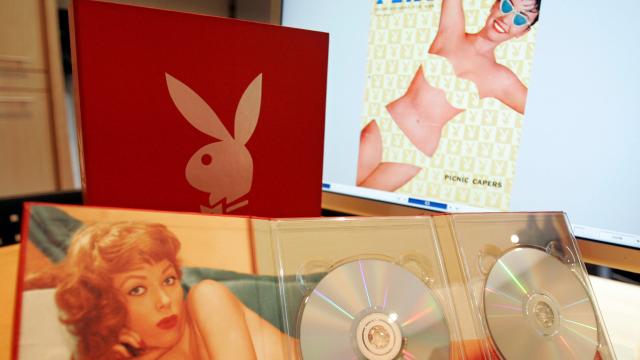Come March of 2016, Playboy magazine is ditching nude photos in favour of the merely scantily clad. (Go ahead and make the joke about reading it for the articles. I’ll wait.) The magazine has struggled to make a profit in a world brimming with free internet pornography. Which is interesting, given Playboy’s long history of experimenting with new media forms.
Here are a few of the ways that Playboy Enterprises brought its brand of sex to the masses.
1954: Printed Magazine
Once upon a time, Playboy only existed as a magazine printed on paper. It sold a very specific fantasy: Readers were encouraged to see themselves as sophisticated men yearning for the wholesome girl-next-door, if the girl next door just happened to be naked and sexually adventurous. The magazine distinguished itself from underground porn by printing high-quality fiction and journalism by the likes of Jack Kerouac, Truman Capote, Roald Dahl, and Arthur C. Clarke, but it was always the sex, or the promise of it, that moved the product.
1959: Broadcast Television
Company ventures that favoured the sophistication over the sex didn’t tend to last. When the company tried its hand at a syndicated television variety show in 1959, they put Playmates in front of the camera, but in evening dresses rather than au naturelle. Playboy’s Penthouse could give you Lenny Bruce, a young Bob Newhart, Nat ‘King’ Cole, and Ella Fitzgerald, but FCC regulations on open broadcasts meant that they couldn’t give viewers nude views, and without that incentive the show lasted only two seasons.
1982: Cable Television
A mere year after MTV’s debut, Playboy brought its brand of porn to the expanding subscription-only cable television market. The Playboy channel couldn’t go on the air until 8 PM and had to sign off at 6 AM, around the same time kids were waking up to Davey and Goliath, but it attracted some 400,000 subscribers in its first four months of operation.
In 1989, they added pay-per-view to the mix, which let viewers choose exactly which R-rated movies, nude soap operas, stand-up comedy, and porn-without-explicit-intercourse they wanted to charge to their credit card. By 1994, most Playboy TV offerings were being consumed as pay-per-view one-offs, and the company responded by buying channels like SpiceTV to offer more explicit content without besmirching the Playboy name.
1982: Home Video
If a Playboy TV subscription wasn’t private enough for you, videotapes were an option. The company repackaged Playboy magazine content on tape, and by the late 1980s ‘video centerfolds’ were regularly spending weeks near the top of the Billboard charts. As viewer habits shifted, the company moved many of these efforts to CD-ROM and DVD .
1994: Internet
The first iteration of Playboy.com launched just a year after Mosaic introduced college students to the joys of web browsing. It was an edgy move, given that most people still didn’t know what the internet even was. But while the site averaged more than a million hits a day its first year, it wasn’t a place where you could buy porn, at least not directly. It was an electronic ad for Playboy products in other media, reprinting excerpts of articles from the magazine, photos of clothed Playmates, and loads of ads for Playboy merch. If you wanted more, you could buy a subscription to the magazine or a TV channel.
But the company quickly figured out that computer screens offered an even more private door into viewer’s homes than television, one without the production costs of videotapes. They launched a subscription option in 1997, with pages of photoshoots pulled from their archives and web-only Playboy Cyber Girls as an incentive.
2014: No More Internet Nudes
Well, sort of. In 2011, Playboy Enterprises outsourced all their internet sites and TV channels to Manwin (now porn juggernaut MindGeek): some properties, like SpiceTV, they sold outright, but they retain an interest in everything with the Playboy name attached. In 2014, the company bought back the rights to use Playboy.com, and by the end of the year had banned nudes from the site.
Articles on the new, porn-free, Playboy.com can theoretically be shared on social media and browsed from work, except that you’re still looking at Playboy. There may be no nudes in what Playboy CEO Scott Flanders called their “Fifth Avenue storefront” in the New York Times, but the internal links to explicit material at PlayboyPlus and Playboy.TV are still there.
Maybe that will serve them well when 3D video finally takes off.
AP Photo/Mark Lennihan
